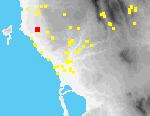 D03
Gargaliani Megas Kambos (2)
D03
Gargaliani Megas Kambos (2)
Site D3 is located ca. 300 m. NE of the knoll of Megas Kambos [D2], within an olive grove on a gentle SW slope. Young trees were planted in 1994/95 in regularly spaced rows between irregularly spaced mature olives.[090.07] There is a line of maquis ca. 5-10 m. from the eastern boundary of the site; artifact densities were highest to the W of it. At the base of some of the older olives there are piles of roughly worked stones, perhaps from collapsed structures.
At the center of the site are two mounds of stone rubble and artifacts, separated by ca. 20 m. The southernmost is ca. 6 m. in diameter[107.27] and 0.5 m. high; the northernmost, ca. 20 m. x 2-3 m. x 1 m. high.[090.10] It is possible that both mounds are remnants of a larger artificial mound which has been largely bulldozed away. In a roughly oval area that includes the two mounds there are no older olives, leading us to hypothesize that there may have been a large maquis-covered mound here that until recently hindered cultivation.
The site of Megas Kambos (2) produced large quantities of both pottery and tile. No clear pattern emerges from the distribution of pottery and tile at the site. The pottery collected ranges in date from Middle-Late Helladic to Modern. The prehistoric pottery is limited in number, consisting of several Middle-Late Helladic coarse ware bodies and two Late Helladic diagnostic sherds. The Turkish-Early Modern period also has a limited but clear representation at the site. The primary period of occupation appears to be Hellenistic to Roman in date. The Late Hellenistic-Early Roman pottery includes many fine wares such as examples of West Slope Ware and Eastern Sigillata A.